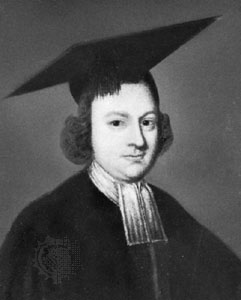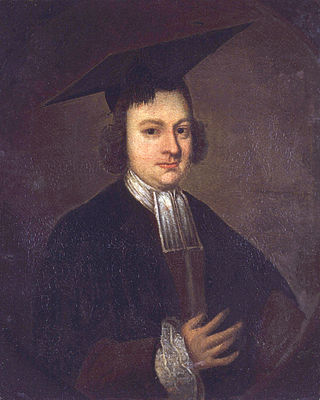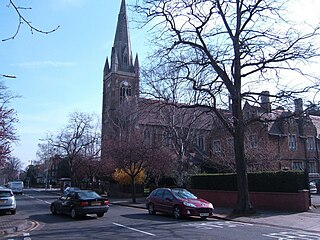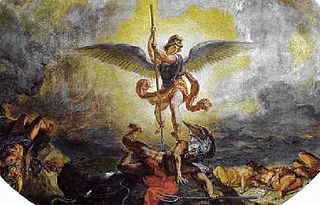
Edward Benjamin Britten, Baron Britten was an English composer, conductor, and pianist. He was a central figure of 20th-century British music, with a range of works including opera, other vocal music, orchestral and chamber pieces. His best-known works include the opera Peter Grimes (1945), the War Requiem (1962) and the orchestral showpiece The Young Person's Guide to the Orchestra (1945).

The War Requiem, Op. 66, is a large-scale setting of the Requiem composed by Benjamin Britten mostly in 1961 and completed in January 1962. The War Requiem was performed for the consecration of the new Coventry Cathedral, which was built after the original fourteenth-century structure was destroyed in a World War II bombing raid. The traditional Latin texts are interspersed, in telling juxtaposition, with extra-liturgical poems by Wilfred Owen, written during World War I.

Christopher Smart was an English poet. He was a major contributor to two popular magazines, The Midwife and The Student, and a friend to influential cultural icons like Samuel Johnson and Henry Fielding. Smart, a high church Anglican, was widely known throughout London.
Zadok the Priest is a British anthem that was composed by George Frideric Handel for the coronation of George II in 1727. Alongside The King Shall Rejoice, My Heart is Inditing, and Let Thy Hand Be Strengthened, Zadok the Priest is one of Handel's coronation anthems. One of Handel's best-known works, Zadok the Priest has been sung prior to the anointing of the sovereign at the coronation of every British monarch since its composition and has become recognised as a British patriotic anthem.

Saint Nicolas, Op. 42, is a cantata with music by Benjamin Britten on a text by Eric Crozier, completed in 1948. It covers the legendary life of Saint Nicholas, Bishop of Myra, Lycia, in a dramatic sequence of events. The composer wrote the work for the centenary of Lancing College in Sussex, with the resources of the institution in mind. It is scored for mixed choir, tenor soloist, four boys singers, strings, piano duet, organ and percussion. The only professionals required are the tenor soloist, a string quintet to lead the other strings, and the percussionists. Saint Nicolas is Britten's first work for amateur musicians, and it includes congregational hymns. The premiere was the opening concert of the first Aldeburgh Festival in June 1948, with Peter Pears as the soloist.

Noye's Fludde is a one-act opera by the British composer Benjamin Britten, intended primarily for amateur performers, particularly children. First performed on 18 June 1958 at that year's Aldeburgh Festival, it is based on the 15th-century Chester "mystery" or "miracle" play which recounts the Old Testament story of Noah's Ark. Britten specified that the opera should be staged in churches or large halls, not in a theatre.

Hodie is a cantata by Ralph Vaughan Williams. Composed between 1953 and 1954, it is the composer's last major choral-orchestral composition, and was premiered under his baton at Worcester Cathedral, as part of the Three Choirs Festival, on 8 September 1954. The piece is dedicated to Herbert Howells. The cantata, in 16 movements, is scored for chorus, boys' choir, organ and orchestra, and features tenor, baritone, and soprano soloists.

Jubilate Agno is a religious poem by Christopher Smart, and was written between 1759 and 1763, during Smart's confinement for insanity in St. Luke's Hospital, Bethnal Green, London. The poem was first published in 1939 under the title Rejoice in the Lamb: A Song from Bedlam, and edited by W. F. Stead from Smart's manuscript, which Stead had discovered in a private library.

A choral symphony is a musical composition for orchestra, choir, and sometimes solo vocalists that, in its internal workings and overall musical architecture, adheres broadly to symphonic musical form. The term "choral symphony" in this context was coined by Hector Berlioz when he described his Roméo et Juliette as such in his five-paragraph introduction to that work. The direct antecedent for the choral symphony is Ludwig van Beethoven's Ninth Symphony. Beethoven's Ninth incorporates part of the Ode an die Freude, a poem by Friedrich Schiller, with text sung by soloists and chorus in the last movement. It is the first example of a major composer's use of the human voice on the same level as instruments in a symphony.

The English poet Christopher Smart (1722–1771) was confined to mental asylums from May 1757 until January 1763. Smart was admitted to St Luke's Hospital for Lunatics, Upper Moorfields, London, on 6 May 1757. He was taken there by his father-in-law, John Newbery, although he may have been confined in a private madhouse before then. While in St Luke's he wrote Jubilate Agno and A Song to David, the poems considered to be his greatest works. Although many of his contemporaries agreed that Smart was "mad", accounts of his condition and its ramifications varied, and some felt that he had been committed unfairly.
The Choral Symphony is a work by Gustav Holst for soprano soloist, chorus, and orchestra in a setting of verses by John Keats. Written in 1923–24, it was premiered in Leeds Town Hall on October 7, 1925, conducted by Albert Coates with Dorothy Silk as soloist. The same performers gave the work's second performance three weeks later in Queen's Hall, London. The work is sometimes known as the First Choral Symphony, although a planned 'second Choral Symphony' never progressed beyond some uncompleted sketches.
A Choral Fantasia, Op. 51, is a work Gustav Holst composed in 1930, setting a selection of verses from Robert Bridges' Ode to Music. Featuring a concertante organ part, A Choral Fantasia also involves a soprano soloist, chorus, string orchestra, brass and percussion.

Prelude and Fugue on a Theme of Vittoria is a work for solo organ composed by Benjamin Britten in 1946. It was commissioned for St Matthew's Church, Northampton and first performed on 21 September 1946, St Matthew's Day, three days after its composition. It uses a theme from a motet by the Spanish composer Vittoria, both in the prelude and as the basis for the fugue. The piece, which lasts about five minutes in performance, has had a mixed reception. One writer has noted the difficulty on finding a suitable organ on which to perform the piece, given the difficulties in finding appropriate registration to meet Britten's requirements. A reviewer of a concert performance in the 1960s called it "a contrived attempt to make bricks without straw", although other commentators have been more favourable about the piece.

The Company of Heaven is a composition for soloists, speakers, choir, timpani, organ, and string orchestra by Benjamin Britten. The title refers to angels, the topic of the work, reflected in texts from the Bible and by poets. The music serves as incidental music for a mostly spoken radio feature which was first heard as a broadcast of the BBC in 1937.

The Te Deum in C is a sacred choral composition by Benjamin Britten, a setting of the Te Deum on the English text from the Book of Common Prayer. Britten wrote it between 11 July and 17 September 1934. It is scored for a treble solo, four-part choir (SATB) and organ.
A Boy Was Born, Op. 3, is a choral composition by Benjamin Britten. Subtitled Choral variations for men's, women's and boys' voices, unaccompanied , it was originally composed from 1932 to 1933. It was first performed on 23 February 1934 as a BBC broadcast. Britten revised the work in 1955. The composer set different texts related to Christmas to music as theme and variations, scored for an a cappella choir with boys' voices.

Benjamin Britten's Jubilate Deo is a sacred choral setting of Psalm 100 in English, written in 1961 for St George's Chapel, Windsor Castle, "at the request of H.R.H. The Duke of Edinburgh". Britten scored the joyful music in C major for four-part choir and organ. A late companion piece to his 1934 Te Deum in C, it is also known as his Jubilate in C. It has been performed and recorded often, including on Prince Philip's 80th and 90th birthdays, and for his funeral service on 17 April 2021.

Hymn to St Peter is a cantata for treble soloist, SATB choir and organ composed by Benjamin Britten in 1955. The piece was the last Britten composed before he first travelled to Asia. He set the text from the gradual of the Feast of Saints Peter and Paul to music which was based on the plainsong of the Alleluia from the hymn. The piece starts with a sombre organ theme in B Flat and when the choir joins in it is initially in unison before breaking into harmonies. After a nimble interlude that recalls children's play, the piece returns to the original theme, ending with a coda played by the organ alone. The piece was first performed at the quincentenary celebrations of St Peter Mancroft, Norwich on 20 November 1955. It was subsequently performed by The Sixteen under Harry Christophers and has frequently been sung with children's voices.
Ian Kellam was a British composer of church music and theatre music.















